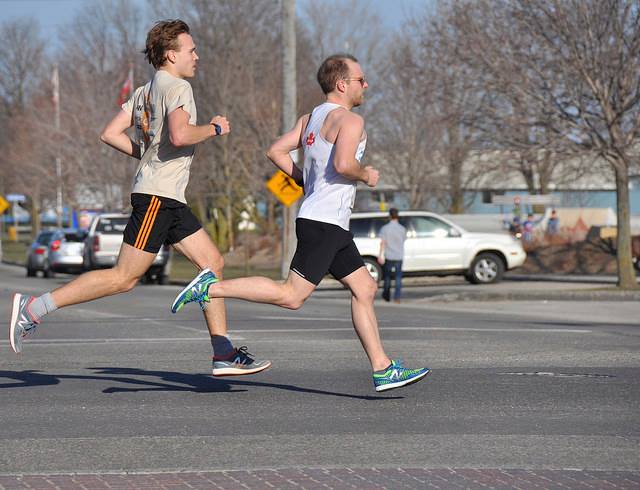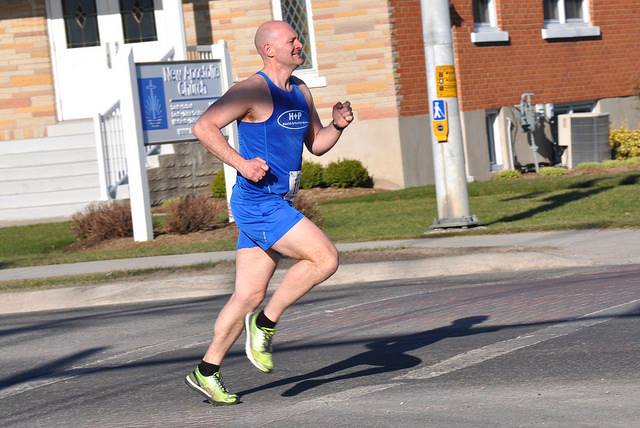Last month I gave an introduction into gait analysis, and a general idea of when one should change their stride. The take home message was that generally speaking, there are times when extreme form flaw can be identified and should be corrected. However, it is also apparent that there is a wide range of what is acceptable, a range that is MUCH broader than we have been led to believe. Altering your natural rhythm to to achieve a narrow view of the perfect stride can decrease running economy and increase injury risk.
Over the next few blog posts, I will be exploring some specific components of form. Today I will take a look at what the research shows about stride length.
Study #1: How changing your stride length alters oxygen consumption
Here’s and old school study from 1952 as a starting point. In this study, they made a subject run at various speeds on the treadmill. They then measured the oxygen consumption and calculated the running economy of that athlete at various stride lengths. Here’s what they found, as an example, at 16km/h:
- -The shortest stride length (139cm) produced an oxygen consumption of 4.03 L/min
- -The longest stride length (169cm) produced an oxygen consumption of 4.53L/min
- -The freely chosen stride length (149cm) produced an oxygen consumption of 3.87 L/min
The most interesting part was that there was a U-shaped relationship among all other stride lengths in between the freely chosen stride length and the longest/shortest options. In other words, when a runner was traveling at 16km/h, the further the stride length changed from the naturally occurring option, the higher the oxygen consumption got.
So sure, the subject is traveling at 16km/h in all the scenarios, but if the natural stride length wasn’t used, more oxygen was needed, and this undoubtedly would come back to bite any runner late in a race!
Study #2: More on oxygen consumption and changing your stride length
So that was 1952, what about 30 years later? Here’s another study, this time from 1982, looking at the impact of stride length on running economy. In this one, 10 recreational runners were watched running at 7 mins/mile for 5 days. During this period, they were not given any instructions and their self-selected stride length was determined. After this period, their stride length was varied by an array of magnitudes of up to 20%. At that 7mins/mile, this is what they found:
- -The average increase in oxygen consumption was 2.6ml/kg-min when the stride was shortened
- -The average increase in oxygen consumption was 3.4ml/kg-min when the stride was lengthened
- -As a control, they re-tested with a self selected stride length. The average increase in oxygen consumption was 0.2ml/kg-min.
So, 30 years later, using a slightly different way of quantifying things, the same trend is clear: try to shorten or lengthen your natural stride, and you will be sucking in more oxygen to maintain the same pace.
Study #3: Changing it up anyway
The above studies are just a few of many examples of this relationship between self-selected stride length and how it tends to optimize running economy.
Of course, as with everything, there are exceptions. This study looked at a group of athletes who did NOT self select the most optimized stride length. In the study, these runners had a 9.8% deviation from optimal stride length which resulted in a 1.46 ml/kg-min additional amount of oxygen consumption from when they went with what felt right.
select the most optimized stride length. In the study, these runners had a 9.8% deviation from optimal stride length which resulted in a 1.46 ml/kg-min additional amount of oxygen consumption from when they went with what felt right.
First of all, it is important to note that these athletes are NOT the norm. It’s weird that they chose a harder stride length at a given pace. In any case, they exist, so can they be fixed? The authors of this study showed that with feedback and training, they certainly can. As they state,
“…these results suggest that short-term audiovisual feedback training can be effective in optimizing step length and producing a decrease in aerobic demand among distance runners exhibiting uneconomical [stride lengths].”
So hope is not lost if you are one of the few who naturally goes with an uneconomical stride length. However, coaching, feedback and some physiological testing would be needed to ensure you are doing the right thing, and not in fact pushing yourself away from an optimal natural stride.
Practical Applications
So as you can see, if you alter your stride length at a given pace, the odds are that you’re going to suck in more oxygen. Over time this is going to slow you down, and that is not good! That is not to say that your stride length will never change when you run. If you go faster, your stride length will increase. If you go slower, your stride length will decrease. Most runners should let this happen naturally. The more you run and the harder you train, the better your body will get at this process.
If you really believe you are among the minority who naturally gravitates to an uneconomical stride, some gait analysis with stride correction tips from a professional can help. However, I think for most of us who have limited time to train, and who run limited miles in the first place, this approach should only be explored in cases of obvious deviations from a normal-ish stride seen with the naked eye, and when other more important performance-enhancing training sessions are being utilized (i.e. long runs, speed work, total mileage, strength training..and the list goes on..)
Dr. Sean Delanghe, BSc. (Hons), DC is a chiropractor, coach, and a regular contributor to the RunWaterloo blog.

